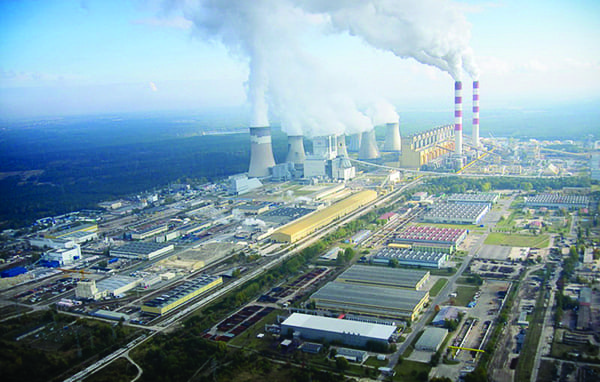OPINIONS
Date: 17 March 2023 Author: Dávid T. Nagy, supervisor: Liliana Śmiech
An Insider of Visegrad Four: Is the nuclear energy good for the Economy of Poland?
Electricity began its conquering journey after the 1881 Paris World Expo, when the exhibited light bulb impressed the audience. Since then, various methods have been tried to meet the continuously growing demand for electricity.

In addition to the coal-fired power plants that emit a lot of harmful substances , experiments have begun to use nuclear energy for peaceful purposes, as they have realized that heat energy is released from the reactor’s chain reaction, which can be used to generate electricity. The first nuclear reactor was launched on December 2, 1942, which only operated for a few minutes, but it proved the theories related to energy release. More than 10 years later, on June 24, 1954, the world’s first nuclear power plant was connected to the Soviet electricity grid in the city of Obninsk, 100 km from Moscow, which was already able to generate energy with increased capacity.
In the era of globalization, people tend to forget how much national economies depend on each other. The energy crisis caused by the Russian-Ukrainian war has caused supply problems in several countries, as Russia is Europe’s largest exporter of oil and natural gas. In hopes of ensuring future energy stability, Poland has prepared plans for building multiple nuclear power plants. Their goal is to continuously ensure local energy supply, thereby reducing the impact of the global gas price on the Polish economy and taking a step closer to energy independence.
To understand the reason for this decision, we need to take a closer look at Poland’s energy mix. We can see that the vast majority of energy is still produced by coal-fired power plants, using both black and brown coal. It’s important to mention that since becoming a member of the European Union, Poland has made significant progress in reducing harmful carbon dioxide emissions, but there is still room for improvement. Over the past 19 years, they have reduced coal-fired power generation by more than 23% and have turned towards alternative solutions.
Today, renewable sources provide about 20% of Poland’s energy supply. For example, wind power covers 10% of energy consumption, bioenergy covers a total of 4.33%, within which the biogas process accounts for 1% of the energy mix. It may sound like a small amount, but looking at it from a different perspective, we learn that it was able to cover the total annual energy consumption of households in Warsaw.
The raw materials for this process are animal manure, agricultural crops, food industry by-products, and suitable municipal waste. Its potential uses include the production of hot water in biogas-fired boilers, combined heat and power generation, and the production of biomethane of natural gas quality, which can later be fed into the gas supply if it meets certain parameters. Experts say that Poland has high potential to multiply the amount of energy produced from biogas, and future facilities will mostly be installed in agricultural zones. Additionally, although to a small extent (4.47%), solar panels also contribute to Poland’s efforts towards green energy.
Reviewing the energy portfolio, we can see that it does not include nuclear energy, as Poland does not yet have a nuclear power plant. It is the only V4 country that has not relied on this type of energy source. Nuclear energy is a significant element of the energy structure in 13 of the European Union’s 27 member states, which accounted for 25% of all energy produced in the EU in 2020.
If we only look at the V4 member countries, according to data from 2022, Slovakia generates over half (58.85%) of its energy needs from nuclear power. This value is also significant in Hungary with 44.62%, where a new investment, the Paks II nuclear power plant, is planned to begin production after 2032, according to official sources. The production of nuclear energy in the Czech Republic may be the lowest among the V4 countries, but with 36.41%, it is still significant on a European level. Based on the numbers, we can say that nuclear energy plays a significant role in the energy structure of the V4 countries.
However, the Polish government has been considering building nuclear power plants for some time, and the Russian aggression in Ukraine has only accelerated this process. According to Mateusz Morawiecki, the Prime Minister of Poland, the country needs a stable energy source that can gradually replace coal-fired power plants, and nuclear energy will be an important element of Poland’s energy independence.
Later, an agreement was reached between the Polish government and the American electric company Westinghouse, which has over a century of history. They won the right to build the first Polish nuclear power plant. Along with French and South Korean competitors, the Polish government chose American technology because it is currently considered the most advanced and state-of-the-art. The work is expected to begin in 2026, and the plant is planned to be capable of producing energy by 2032.
The company says that this investment will provide long-term benefits to the Polish economy. It will allow Poland to reduce its dependence on coal-fired power plants and transition to carbon-free energy production. These sustainability efforts will transform Poland’s international reputation, putting it in a better spotlight for future international cooperation.
During the preparatory and construction work, this investment will provide hundreds of job opportunities, and after its completion, it will provide employment for the local population for decades during operation. It is important to note that cooperation with local small and medium-sized enterprises will receive great emphasis during the construction. According to statements, Westinghouse will collaborate with more than 22 companies during the construction, which is an exceptional opportunity for the local SME sector. This investment creates closer relationships between Poland and the United States, which can be beneficial in many ways for future collaborations.
Dealing with unemployment following the gradual closure of coal-fired power plants will be an important task for the Polish government to address. However, the necessity of this investment for the Polish economy is unquestionable. The war proved that energy independence is of paramount importance, and efforts to achieve this goal must be maximized according to the situation. Looking at it from another perspective, the quotas outlined in the European Green Deal also apply to Poland. It has been determined that net greenhouse gas emissions must be reduced by 55% by 2030 compared to the 1990 level. A radical change was expected in Poland’s energy portfolio. The war that dragged on in the neighboring country and its impact on the economy accelerated this decision. The importance of the investment was particularly evident during the energy war that broke out in Europe, as countries experienced the consequences of energy dependence firsthand.
Sources:
1. https://www.theguardian.com/environment/2022/dec/22/eus-emissions-continue-to-fall-despite-return-to-coal
2. https://ourworldindata.org/energy/country/poland?country=~POL
3. https://ec.europa.eu/eurostat/web/products-eurostat-news/-/DDN-20220111-1
4. https://ourworldindata.org/energy/country/poland?country=SVK~CZE~HUN
5. https://www.reuters.com/world/poland-picks-us-offer-its-first-nuclear-power-plant-pm-2022-10-28/
6. https://info.westinghousenuclear.com/news/poland-selects-wec-ap1000
Support Us
If content prepared by Warsaw Institute team is useful for you, please support our actions. Donations from private persons are necessary for the continuation of our mission.
All texts published by the Warsaw Institute Foundation may be disseminated on the condition that their origin is credited. Images may not be used without permission.

















